Objective 5. Copy, Move, Rename, and Delete Files
Recall that Windows manages your data files because your files are stored on the drives attached to your computer. Copying files from one folder to another is a frequent data management task. For example, you might want to make a backup copy of important information, copy a file from a CD to a local disk, or copy information from your local disk drive to a removable drive. Copying files and folders works the same regardless of the type of driveremovable drive, local disk drive, or shared network drive.
Performing other operations on files, such as deleting them or moving them, also works the same regardless of the type of drive. As you accumulate files, you will likely need to delete some to reduce clutter on your hard drive. You might also want to move documents into other folders on another drive to archive themplace them somewhere for long-term storage. Finally, you may want to change the names of files or folders to make the names more descriptive. All of these tasks are functions of your Windows operating system.
Activity 1.5. Copying Files and Folders
In the following activity, you will copy files onto your removable drive and into the folders you created in Activity 1.4.
|
1. |
Be sure your My Computer window is displayed, and that the Folders button on the toolbar is selected and the Folders task pane is displayed on the left. Place the student CD that came with this book in the CD drive. In the Folders task pane, click the expand button (+) to the left of the CD drive to display the contents of the drive. If a go2003_2e dialog box opens, click Cancel. NoteIf Your Student Files Are in a Different Location Some instructors will place the student files in a folder on a shared network drive, or in a file-sharing folder in a course Web site. If you are instructed to use files from another source, follow the instructions below, substituting your file location for the CD drive. |
|
|
|
|
2. |
In the Folders task pane, click the expand button (+) to the left of the Go! Office 2003 2e folder, click the expand button (+) to the left of Windows XP, and then click the Chapter01 folder. If necessary, on the Standard Buttons toolbar, click the Views button Figure 1.30. 
The subfolders in the Chapter01 folder display in the Folders task pane on the left, and the subfolders and files in the Chapter01 folder display in the right pane. The files you see may display three letters following the file name, such as .doc. These are file extensions, and most files have these extensionsalthough they may or may not display on your system. Files created by Microsoft Office programs have a standard set of extensions that identify the type of program used to create the file. For example, Microsoft Word documents end in .doc, Excel spreadsheets end in .xls, PowerPoint presentations end with .ppt, and so on. |
|
3. |
On the menu bar, click Tools, and then from the displayed menu, click Folder Options. Near the top of the Folder Options dialog box, click the View tab. Under Advanced settings, locate the Hide extensions for known file types check box. If the check box is checked (selected) click to clear the check box, and then compare your screen with Figure 1.31. Figure 1.31. 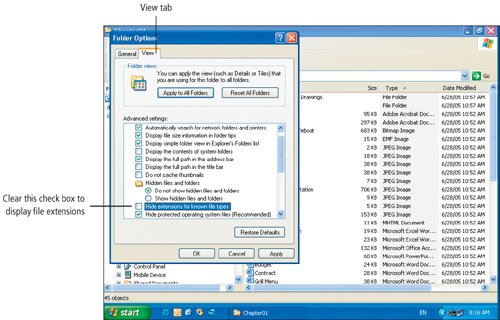
In this chapter, from this point on, it is assumed that the file extensions are turned on and will display. |
|
4. |
Click OK to close the Folder Options dialog box. In the Folders task pane, click the removable drive you used to create the Pictures of Firstname Lastname and Word Documents of Firstname Lastname folders. Click the Chapter01 folder, which refreshes the window and re-displays the file names with their file extensions. In the right pane, click the Type column heading. Be sure you can see all of the WMF files. |
|
5. |
In the Name column, click to select the Flower.wmf file. In the Folders task pane, scroll as necessary until you can see your removable drive. Watch the shape of the pointer and begin to drag the Flower.wmf file over to the Pictures folder you created on your removable drive. The Pictures folder on your removable drive is selected, and the file name is attached to the pointer, as shown in Figure 1.32. When you release the mouse button, the file will be copied. Files are copied when dragged to a different drive, and moved when dragged to a different location in the same drive. Figure 1.32. 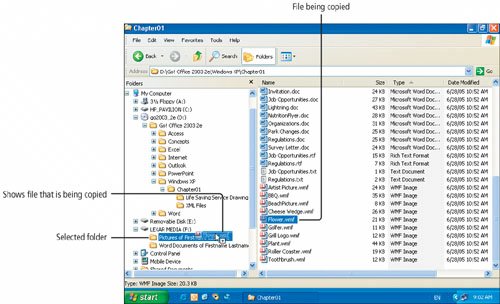
|
|
6. |
Release the mouse button to copy the file to the Pictures of Firstname Lastname folder. |
|
7. |
In the Name column, click to select the Plant.wmf file. From the Edit menu, click Copy. |
|
|
|
|
8. |
In the Folders task pane, click to select the Pictures of Firstname Lastname folder. From the Edit menu, click Paste. Compare your screen to Figure 1.33. Figure 1.33. 
The file is copied to the selected folder, and the folder contains two filesthe file you dragged to the folder and the file you pasted into the folder. You can see that there are various ways in which you can copy a file from one location to another. |
|
9. |
In the Folders task pane, under the CD containing your student files, click to select the Chapter01 folder. In the Name column, scroll as necessary, and then click to select the Roller Coaster.wmf file. Then, hold down |
|
10. |
From the File menu, point to Send To, and then click the name of your removable disk drive. |
|
11. |
In the right pane, click the Name column heading, and then scroll to the top of the list of folders and files. In the Folders task pane, scroll down if necessary to see your removable drive. Drag the XML Files folder over the name of your removable drive until it is selected, and then release the mouse button. Compare your screen with Figure 1.34. Figure 1.34. 
The folder and all of the files in the folder are copied to your removable drive. |
Activity 1.6. Moving, Renaming, and Deleting Files
In the following activity, you will move files from one location on your removable drive to another location on the same drive. You will also rename and delete files.
|
1. |
In the Folders task pane, scroll down if necessary and then click the removable drive you are using to store your files. In the right pane, click the Name column as necessary to display the files in alphabetical order. Click the Views button arrow Figure 1.35. 
The two folders you created and three of the files you copied display in the right pane. Small thumbnail images of the filesminiature images of the pictures in the filesdisplay in the right pane. These thumbnails make it easy to select the correct file when you have a folder that contains a large number of images. Folders that contain pictures display thumbnails of up to four of the images in a large file folder icon. |
|
2. |
In the right pane, click the Artist Picture.wmf file. Hold down the mouse button, drag the file to the Pictures of Firstname Lastname folder that you created, and then release the mouse button. |
|
3. |
Drag the Golfer.wmf file to the Pictures folder, and then drag the Roller Coaster.wmf file to the Pictures folder. |
|
4. |
In the Folders task pane, click the Pictures of Firstname Lastname folder in your removable drive. On the Standard Buttons toolbar click the Views button Figure 1.36. 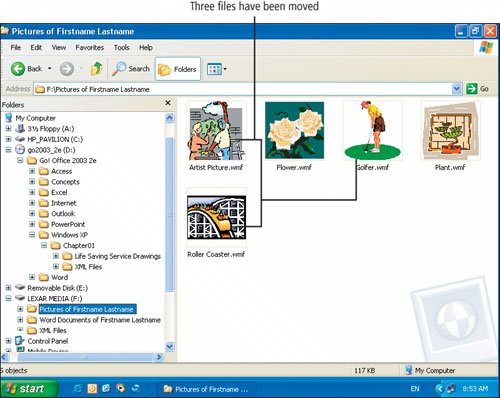
|
|
5. |
In the right pane, right-click the Flower.wmf file. Then, from the displayed shortcut menu, click the Rename command. Click to position the insertion point at the beginning of the file name, type Water and then press Figure 1.37. (This item is displayed on page 42 in the print version) 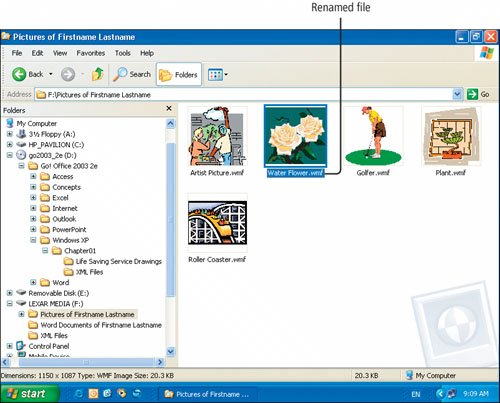
When the file extensions are displayed, you need to include the extension when you rename the file. There are several restrictions for naming files or folders. A file name can contain up to 255 characters, including spaces, although the file name cannot begin with a space. It also cannot contain the following characters: / : * ? " < > | |
|
|
|
|
6. |
In the right pane, click to select the Plant.wmf file, and then press NoteIf You Cannot Delete a File Sometimes you will try to delete a file and a dialog box displays indicating that the file cannot be deleted. This usually means that the file is open. You must close a file before you can delete it. |
|
7. |
In the Folders task pane, click to select your removable disk. In the right pane, select the XML Files folder, and then press |
|
|
|
|
8. |
In the Confirm Folder Delete dialog box, click Yes to delete the folder. |
More Knowledge: Recovering Deleted Files
If you accidentally delete a file that you want to keep from a hard disk drive, there is a good chance you can recover it. Windows temporarily stores files deleted from your hard drive in a Recycle Bin, which you can find on the desktop or in the My Computer Folders pane. You can open the Recycle Bin in the same way as you open a file folder. If the discarded files have not been permanently removed, right-click the file name in the Contents pane and click Restore in the shortcut menu.
Activity 1.7. Capturing an Image of a Screen
Windows includes a screen capture utility so that you can capture an image of your screen and then print it or save it as a file.
|
1. |
On your keyboard, locate and press |
|
2. |
Click the Start button |
|
3. |
In the WordPad window, type Firstname Lastname using your own name. Press |
|
|
|
|
4. |
From the WordPad menu bar, click Edit, and then click Paste. Compare your screen with Figure 1.38. Figure 1.38. 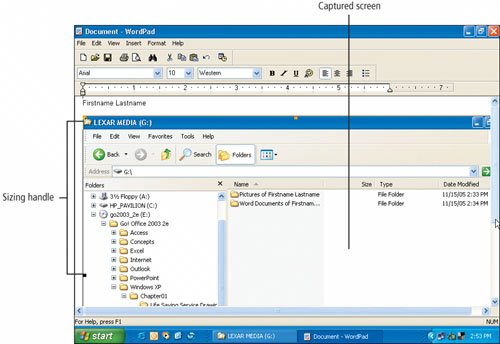
The captured screen is pasted at the insertion point. The image is larger than the WordPad page. |
|
5. |
In the lower right corner of the image, move the pointer over the sizing handlethe little box in the cornerto display the diagonal resize pointer |
|
|
|
|
6. |
With the diagonal resize pointer Figure 1.39. 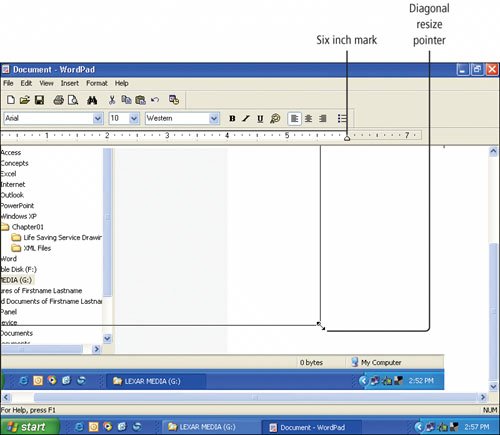
Recall that to drag an object, you need to point, click, and move the mouse to the desired location. Use the ruler as a guide. |
|
7. |
From the File menu, click Print Preview to display the Print Preview window. Compare your screen to Figure 1.40. Figure 1.40. 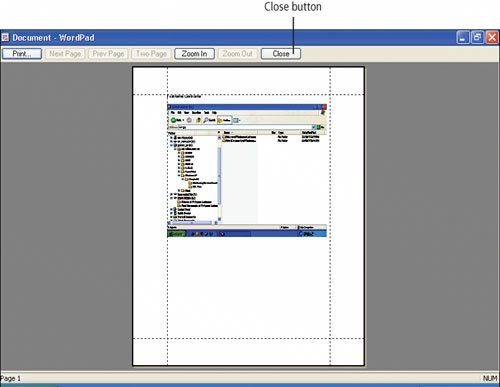
Alert!: What To Do If the Image Does Not Display in Print Preview On some computers, if the image is larger than the page, the image will not display. If you cannot see your pasted image, close the Print Preview window and use the sizing handle to reduce the size of the image again. Repeat this procedure until you can see the image in Print Preview. |
|
8. |
In the Print Preview title bar, click the red Close button |
|
9. |
Check your Course Syllabus or Chapter Assignment Sheet, or ask your instructor, to determine if you are to submit a printed or electronic copy of this file. To print, from the WordPad toolbar, click the Print button |
|
10. |
From the File menu, click Exit. When prompted to save your work, click No. |
Objective 6 Find Files and Folders |
Windows XP
- Chapter One. Getting Started with Windows XP
- Project 1A. Windows XP
- Objective 1. Get Started with Windows XP
- Objective 2. Resize, Move, and Scroll Windows
- Objective 3. Maximize, Restore, Minimize, and Close a Window
- Objective 4. Create a New Folder
- Objective 5. Copy, Move, Rename, and Delete Files
- Objective 6. Find Files and Folders
- Objective 7. Compress Files
- Summary
- Key Terms
- Concepts Assessments
Outlook 2003
- Chapter One. Getting Started with Outlook 2003
- Getting Started with Microsoft Office Outlook 2003
- Project 1A. Exploring Outlook 2003
- Objective 1. Start and Navigate Outlook
- Objective 2. Read and Respond to E-mail
- Objective 3. Store Contact and Task Information
- Objective 4. Work with the Calendar
- Objective 5. Delete Outlook Information and Close Outlook
- Summary
- Key Terms
- Concepts Assessments
- Skill Assessments
- Performance Assessments
- Mastery Assessments
- Problem Solving
- GO! with Help
Internet Explorer
- Chapter One. Getting Started with Internet Explorer
- Getting Started with Internet Explorer 6.0
- Project 1A. College and Career Information
- Objective 1. Start Internet Explorer and Identify Screen Elements
- Objective 2. Navigate the Internet
- Objective 3. Create and Manage Favorites
- Objective 4. Search the Internet
- Objective 5. Save and Print Web Pages
- Summary
- Key Terms
- Concepts Assessments
- Skill Assessments
- Performance Assessments
- Mastery Assessments
- Problem Solving
Computer Concepts
- Chapter One. Basic Computer Concepts
- Objective 1. Define Computer and Identify the Four Basic Computing Functions
- Objective 2. Identify the Different Types of Computers
- Objective 3. Describe Hardware Devices and Their Uses
- Objective 4. Identify Types of Software and Their Uses
- Objective 5. Describe Networks and Define Network Terms
- Objective 6. Identify Safe Computing Practices
- Summary
- In this Chapter You Learned How to
- Key Terms
- Concepts Assessments
Word 2003
Chapter One. Creating Documents with Microsoft Word 2003
- Chapter One. Creating Documents with Microsoft Word 2003
- Getting Started with Microsoft Office Word 2003
- Project 1A. Thank You Letter
- Objective 1. Create and Save a New Document
- Objective 2. Edit Text
- Objective 3. Select, Delete, and Format Text
- Objective 4. Create Footers and Print Documents
- Project 1B. Party Themes
- Objective 5. Navigate the Word Window
- Objective 6. Add a Graphic to a Document
- Objective 7. Use the Spelling and Grammar Checker
- Objective 8. Preview and Print Documents, Close a Document, and Close Word
- Objective 9. Use the Microsoft Help System
- Summary
- Key Terms
- Concepts Assessments
- Skill Assessments
- Performance Assessments
- Mastery Assessments
- Problem Solving
- You and GO!
- Business Running Case
- GO! with Help
Chapter Two. Formatting and Organizing Text
- Formatting and Organizing Text
- Project 2A. Alaska Trip
- Objective 1. Change Document and Paragraph Layout
- Objective 2. Change and Reorganize Text
- Objective 3. Create and Modify Lists
- Project 2B. Research Paper
- Objective 4. Insert and Format Headers and Footers
- Objective 5. Insert Frequently Used Text
- Objective 6. Insert and Format References
- Summary
- Key Terms
- Concepts Assessments
- Skill Assessments
- Performance Assessments
- Mastery Assessments
- Problem Solving
- You and GO!
- Business Running Case
- GO! with Help
Chapter Three. Using Graphics and Tables
- Using Graphics and Tables
- Project 3A. Job Opportunities
- Objective 1. Insert and Modify Clip Art and Pictures
- Objective 2. Use the Drawing Toolbar
- Project 3B. Park Changes
- Objective 3. Set Tab Stops
- Objective 4. Create a Table
- Objective 5. Format a Table
- Objective 6. Create a Table from Existing Text
- Summary
- Key Terms
- Concepts Assessments
- Skill Assessments
- Performance Assessments
- Mastery Assessments
- Problem Solving
- You and GO!
- Business Running Case
- GO! with Help
Chapter Four. Using Special Document Formats, Columns, and Mail Merge
- Using Special Document Formats, Columns, and Mail Merge
- Project 4A. Garden Newsletter
- Objective 1. Create a Decorative Title
- Objective 2. Create Multicolumn Documents
- Objective 3. Add Special Paragraph Formatting
- Objective 4. Use Special Character Formats
- Project 4B. Water Matters
- Objective 5. Insert Hyperlinks
- Objective 6. Preview and Save a Document as a Web Page
- Project 4C. Recreation Ideas
- Objective 7. Locate Supporting Information
- Objective 8. Find Objects with the Select Browse Object Button
- Project 4D. Mailing Labels
- Objective 9. Create Labels Using the Mail Merge Wizard
- Summary
- Key Terms
- Concepts Assessments
- Skill Assessments
- Performance Assessments
- Mastery Assessments
- Problem Solving
- You and GO!
- Business Running Case
- GO! with Help
Excel 2003
Chapter One. Creating a Worksheet and Charting Data
- Creating a Worksheet and Charting Data
- Project 1A. Tableware
- Objective 1. Start Excel and Navigate a Workbook
- Objective 2. Select Parts of a Worksheet
- Objective 3. Enter and Edit Data in a Worksheet
- Objective 4. Construct a Formula and Use the Sum Function
- Objective 5. Format Data and Cells
- Objective 6. Chart Data
- Objective 7. Annotate a Chart
- Objective 8. Prepare a Worksheet for Printing
- Objective 9. Use the Excel Help System
- Project 1B. Gas Usage
- Objective 10. Open and Save an Existing Workbook
- Objective 11. Navigate and Rename Worksheets
- Objective 12. Enter Dates and Clear Formats
- Objective 13. Use a Summary Sheet
- Objective 14. Format Worksheets in a Workbook
- Summary
- Key Terms
- Concepts Assessments
- Skill Assessments
- Performance Assessments
- Mastery Assessments
- Problem Solving
- You and GO!
- Business Running Case
- GO! with Help
Chapter Two. Designing Effective Worksheets
- Designing Effective Worksheets
- Project 2A. Staff Schedule
- Objective 1. Use AutoFill to Fill a Pattern of Column and Row Titles
- Objective 2. Copy Text Using the Fill Handle
- Objective 3. Use AutoFormat
- Objective 4. View, Scroll, and Print Large Worksheets
- Project 2B. Inventory Value
- Objective 5. Design a Worksheet
- Objective 6. Copy Formulas
- Objective 7. Format Percents, Move Formulas, and Wrap Text
- Objective 8. Make Comparisons Using a Pie Chart
- Objective 9. Print a Chart on a Separate Worksheet
- Project 2C. Population Growth
- Objective 10. Design a Worksheet for What-If Analysis
- Objective 11. Perform What-If Analysis
- Objective 12. Compare Data with a Line Chart
- Summary
- Key Terms
- Concepts Assessments
- Skill Assessments
- Performance Assessments
- Mastery Assessments
- Problem Solving
- You and GO!
- Business Running Case
- GO! with Help
Chapter Three. Using Functions and Data Tables
- Using Functions and Data Tables
- Project 3A. Geography Lecture
- Objective 1. Use SUM, AVERAGE, MIN, and MAX Functions
- Objective 2. Use a Chart to Make Comparisons
- Project 3B. Lab Supervisors
- Objective 3. Use COUNTIF and IF Functions, and Apply Conditional Formatting
- Objective 4. Use a Date Function
- Project 3C. Loan Payment
- Objective 5. Use Financial Functions
- Objective 6. Use Goal Seek
- Objective 7. Create a Data Table
- Summary
- Key Terms
- Concepts Assessments
- Skill Assessments
- Performance Assessments
- Mastery Assessments
- Problem Solving
- You and GO!
- Business Running Case
- GO! with Help
Access 2003
Chapter One. Getting Started with Access Databases and Tables
- Getting Started with Access Databases and Tables
- Project 1A. Academic Departments
- Objective 1. Rename a Database
- Objective 2. Start Access, Open an Existing Database, and View Database Objects
- Project 1B. Fundraising
- Objective 3. Create a New Database
- Objective 4. Create a New Table
- Objective 5. Add Records to a Table
- Objective 6. Modify the Table Design
- Objective 7. Create Table Relationships
- Objective 8. Find and Edit Records in a Table
- Objective 9. Print a Table
- Objective 10. Close and Save a Database
- Objective 11. Use the Access Help System
- Summary
- Key Terms
- Concepts Assessments
- Skill Assessments
- Performance Assessments
- Mastery Assessments
- Problem Solving Assessments
- Problem Solving
- You and GO!
- Business Running Case
- GO! with Help
Chapter Two. Sort, Filter, and Query a Database
- Sort, Filter, and Query a Database
- Project 2A. Club Fundraiser
- Objective 1. Sort Records
- Objective 2. Filter Records
- Objective 3. Create a Select Query
- Objective 4. Open and Edit an Existing Query
- Objective 5. Sort Data in a Query
- Objective 6. Specify Text Criteria in a Query
- Objective 7. Print a Query
- Objective 8. Specify Numeric Criteria in a Query
- Objective 9. Use Compound Criteria
- Objective 10. Create a Query Based on More Than One Table
- Objective 11. Use Wildcards in a Query
- Objective 12. Use Calculated Fields in a Query
- Objective 13. Group Data and Calculate Statistics in a Query
- Summary
- Key Terms
- Concepts Assessments
- Skill Assessments
- Performance Assessments
- Mastery Assessments
- Problem Solving
- You and GO!
- Business Running Case
- GO! with Access Help
Chapter Three. Forms and Reports
- Forms and Reports
- Project 3A. Fundraiser
- Objective 1. Create an AutoForm
- Objective 2. Use a Form to Add and Delete Records
- Objective 3. Create a Form Using the Form Wizard
- Objective 4. Modify a Form
- Objective 5. Create an AutoReport
- Objective 6. Create a Report Using the Report Wizard
- Objective 7. Modify the Design of a Report
- Objective 8. Print a Report and Keep Data Together
- Summary
- Key Terms
- Concepts Assessments
- Skill Assessments
- Performance Assessments
- Mastery Assessments
- Problem Solving
- You and GO!
- Business Running Case
- GO! with Help
Powerpoint 2003
Chapter One. Getting Started with PowerPoint 2003
- Getting Started with PowerPoint 2003
- Project 1A. Expansion
- Objective 1. Start and Exit PowerPoint
- Objective 2. Edit a Presentation Using the Outline/Slides Pane
- Objective 3. Format and Edit a Presentation Using the Slide Pane
- Objective 4. View and Edit a Presentation in Slide Sorter View
- Objective 5. View a Slide Show
- Objective 6. Create Headers and Footers
- Objective 7. Print a Presentation
- Objective 8. Use PowerPoint Help
- Summary
- Key Terms
- Concepts Assessments
- Skill Assessments
- Performance Assessments
- Mastery Assessments
- Problem Solving
- You and GO!
- Business Running Case
- GO! with Help
Chapter Two. Creating a Presentation
- Creating a Presentation
- Project 2A. Teenagers
- Objective 1. Create a Presentation
- Objective 2. Modify Slides
- Project 2B. History
- Objective 3. Create a Presentation Using a Design Template
- Objective 4. Import Text from Word
- Objective 5. Move and Copy Text
- Summary
- Key Terms
- Concepts Assessments
- Skill Assessments
- Performance Assessments
- Mastery Assessments
- Problem Solving
- You and GO!
- Business Running Case
- GO! with Help
Chapter Three. Formatting a Presentation
- Project 3A. Emergency
- Objective 1. Format Slide Text
- Objective 2. Modify Placeholders
- Objective 3. Modify Slide Master Elements
- Objective 4. Insert Clip Art
- Project 3B. Volunteers
- Objective 5. Apply Bullets and Numbering
- Objective 6. Customize a Color Scheme
- Objective 7. Modify the Slide Background
- Objective 8. Apply an Animation Scheme
- Summary
- Key Terms
- Concepts Assessments
- Skill Assessments
- Performance Assessments
- Mastery Assessments
- Problem Solving
- You and GO!
- Business Running Case
- GO! with Help
Integrated Projects
Chapter One. Using Access Data with Other Office Applications
- Chapter One. Using Access Data with Other Office Applications
- Introduction
- Project 1A. Meeting Slides
- Objective 1. Export Access Data to Excel
- Objective 2. Create a Formula in Excel
- Objective 3. Create a Chart in Excel
- Objective 4. Copy Access Data into a Word Document
- Objective 5. Copy Excel Data into a Word Document
- Objective 6. Insert an Excel Chart into a PowerPoint Presentation
Chapter Two. Using Tables in Word and Excel
- Chapter Two. Using Tables in Word and Excel
- Introduction
- Project 2A. Meeting Notes
- Objective 1. Plan a Table in Word
- Objective 2. Enter Data and Format a Table in Word
- Objective 3. Create a Table in Word from Excel Data
- Objective 4. Create Excel Worksheet Data from a Word Table
Chapter Three. Using Excel as a Data Source in a Mail Merge
- Chapter Three. Using Excel as a Data Source in a Mail Merge
- Introduction
- Project 3A. Mailing Labels
- Objective 1. Prepare a Mail Merge Document as Mailing Labels
- Objective 2. Choose an Excel Worksheet as a Data Source
- Objective 3. Produce and Save Merged Mailing Labels
- Objective 4. Open a Saved Main Document for Mail Merge
Chapter Four. Linking Data in Office Documents
- Chapter Four. Linking Data in Office Documents
- Introduction
- Project 4A. Weekly Sales
- Objective 1. Insert and Link in Word an Excel Object
- Objective 2. Format an Object in Word
- Objective 3. Open a Word Document That Includes a Linked Object, and Update Links
Chapter Five. Creating Presentation Content from Office Documents
EAN: 2147483647
Pages: 448
 , and then click Details. Compare your screen with Figure 1.30.
, and then click Details. Compare your screen with Figure 1.30. and click the Golfer.wmf file and the Artist Picture.wmf file.
and click the Golfer.wmf file and the Artist Picture.wmf file. . Press
. Press  to change the file name to Water Flower.wmf. Compare your screen with Figure 1.37.
to change the file name to Water Flower.wmf. Compare your screen with Figure 1.37. . In the Confirm File Delete message box, click Yes.
. In the Confirm File Delete message box, click Yes. .
. , point to All Programs, point to Accessories, and then click WordPad. If necessary, Maximize
, point to All Programs, point to Accessories, and then click WordPad. If necessary, Maximize  the WordPad window.
the WordPad window. .
. . Alternatively, click the Close button on the Print Preview toolbar.
. Alternatively, click the Close button on the Print Preview toolbar. . To submit electronically using your college's course management system, consult your instructor's directions for saving and submitting the file.
. To submit electronically using your college's course management system, consult your instructor's directions for saving and submitting the file.